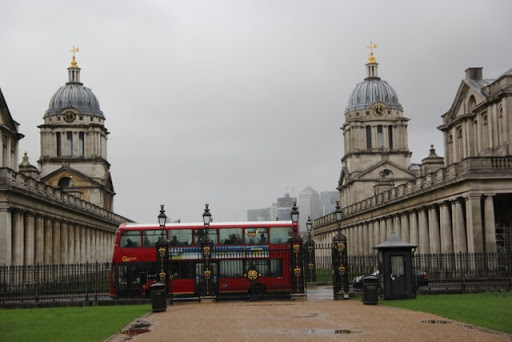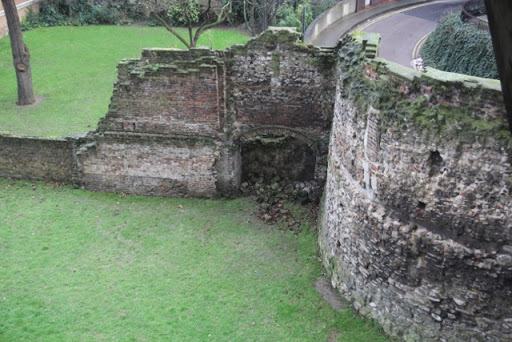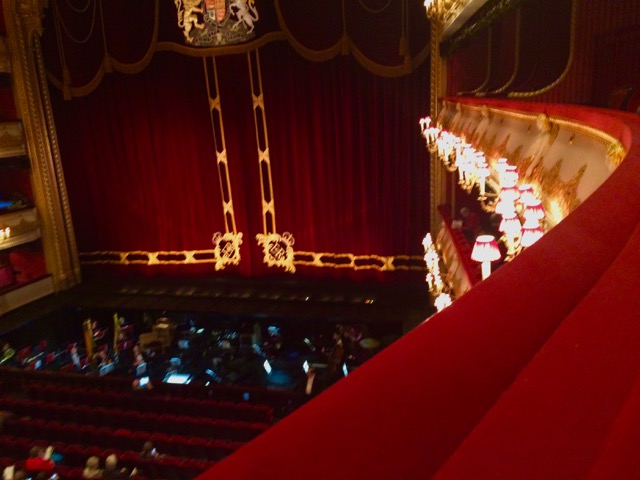Cold Play ... But Every Day? London in Winter
Now...it did not start well. A wifely expletive, just as I'd closed the door of the apartment; the gut-chilling realisation that the security swipe card and keys were inside. So too, the bag containing the flight tickets and a wad of currency. Duck indeed! Contact the building manager. He'd gone home. Messages left, taxi cancelled. Time critical, called Wendy's daughter Emily, a last resort. She had a spare key and security swipe card, but was also 25 minutes away, and with Sydney traffic ... She drove a la Seb Vettel and like Blucher to Wellington at Waterloo, she arrived in the nick of time, saved the day, delivering us to the airport with a minute before the flight closed. Yes, it was that close.
Flight to London long, uncomfortable, arduous, lousy food and service, awful movies, no news, hard, narrow seats, 14 hours to Dubai on a packed Airbus 380. Wonderful access to the lounge, wife a cigarette and a champers, me a rushed shower, back on board for 7 more hours; misty Heathrow. After such lengthy seating, it was good to walk the 'miles' to Immigration and Customs, then a rattling ride on the Piccadilly line to Green Square and down the mole hole to the Jubilee Line. Out at the ultra modern Canary Wharf station. Blotted my copy book by tumbling down the escalator when the heavy suitcase dropped anchor, me stupidly holding on. Suitcase rescued by a polished Brit, a lawyer probably, immaculately dressed and with a black Ushanka hat.
"You okay old chap?"
I nodded, shaken and stirred, and moments later we met our friends. Champers for the wives and our host, a whisky - single malt, of course, for me. Old friends, we bonded again immediately, then up to their luxurious eyrie with views, on a clear day, down the Thames to its mouth, and up Thames to the distant Shard. We relaxed, more champagne, chatted volubly till 9pm. What jet-lag? What cold? We were inside, and warm.

We slept as befits those awake for over 30 hours. There is no point getting up till at least 8.00 when the light drizzles into being, the coffee and the vista too. By 9am the view was slightly better, stupendous in its revelation, paths filled with the trudgery to drudgery crowds, still the unending pearl necklace of the cars, bearing the unseen on the way to work. A light leisurely breakfast and then pithily planning. Time was short and many of the main sights, the Houses of Parliament, the Tower of London, St Paul's, were already old acquaintances, the Thames too, a nodding relationship. Our friends had never been to Gordon's Wine Bar, where a part of my novel, What the Eye Cannot See, is set. It therefore went onto the List. Like so much of London, Gordons never changes, intriguing financiers and speculators, lovers for clandestine assignations, all meeting by candlelight, over wines and open sandwiches or cheese platters, in an old coal cellar at the Embankment.

River view to the Mouth of the Thames - mid ground old Millennium Olympic Stadium (dome)
On the morrow, when the drizzle had turned to rain, we set out for Greenwich and the Maritime Museum, a wonderful place to spend long days, but this time, short hours to see the wonderful Samuel Pepys exhibition. Pepys, who is best known for his remarkable diary, giving contemporary views of significant 17th Century events including the return to England and subsequent beheading of King Charles I, the London Plague, the Great Fire of 1666, the Anglo-Dutch naval conflict, was a great all-rounder. An excellent scholar, the Cambridge educated Pepys was a senior administrator who professionalised the British navy, an adept Parliamentarian, self taught mathematician, and scientist. He also headed the Royal Society for British endeavour.

Greenwich Navel College from the Maritime Museum
The exhibition featured a wonderful array of painting and personal items from throughout his life, and of course, the one of diaries (he only maintained them for a decade in mid-life). It is ironic that one of the first scholars who for years grappled with "translating" all the diaries (Pepys used his own unique 'shorthand' to hide details of many salacious events) after gaining access to them from the National Archives, only discovered when almost at completion of his work, that in the shelf above the diaries, there was Pepys' own manual on his shorthand interpretations!
There is also a very graphic computer generated depiction of the Great Fire. It destroyed Pepy's own house, and he took to a boat on the Thames to watch its spread. His contemporary writings of events remained resource material for history scholars, over the centuries.
He also gave sound advice, due to his own urinary disorder, for we who grow older. Any man who passes a toilet when there is an opportunity, is a fool. Sage advice, but in London an expensive business! At Waterloo station, for example, and many other public places, make sure you have 70p in your pocket for your pee. Otherwise, your way is barred and let's face it, at 65 you are too old to leap over the bars!
Amid the showers and in the shadow of the famous tea clipper, the Cutty Sark, we lunched at the Admiral Hardy pub. While the rest had wine, I had a half pint of Friggin' in the Riggin' ale. The Admiral, famous for his sea skills but immortalised for holding the dying Nelson on the deck of HMS Victory, would have approved of my toast, "To health and kismet."

HMS Belfast, the Tower of London, Tower Bridge
Our Bucket List included the Geffrye Museum, a property built in 1714 by Sir Robert Geffrye, the then Lord Mayor of London, as almshouses for the poor. It is in Hackney, within earshot of the "bells of Shoreditch," known to my generation from the nursery rhyme, Oranges and Lemons. The museum is full of period furnished rooms, indicative of how the London "middle-class" houses/apartments evolved over the centuries, right up to contemporary times. Fascinating stuff, especially regarding "the woman's place!" Windows to the world, from the 16th to 19th century, were habitually darkened by soot and smoke, playing havoc with needlework, sewing, and writing. Much work was done by candlelight, resulting in eye related issues, and the growth of the eye-glass industry! Table settings changed from "including the servants," to later providing them in their "own quarters," usually in the cellar or attic. It is a room by room showing of "advancement" in furniture development to the 20th century love of minimalism and "Swedish design." A great find indeed.
So too, was the little heralded - although decidedly popular, Museum of London, although again time was a thief. I rushed through the early "cave-dweller" settlements and the Roman development of the city of Londinium, the opening up of the countryside through the bridging of the Thames. The museum is set within the Wall which the Romans built around the settlement from 190 to 225AD, with a well developed port, meeting halls and bath places to say nothing of villas for creature comforts. Again, so much to explore in the development of London although I did rush through a wonderful Victoriana street ensemble.

Roman Walls around Londinium from the Museum of London
Afterwards we 'repaired' to the olde Cheshire Cheese on Fleet St, the original which was destroyed in the Great Fire. The "current one" dates from 1668. You walk through its lane door and into a dark interior, illuminated by the presence of literary greatness, a veritable Who's Who of the written lingo, Dickens, Conan Doyle, Tennyson, Wodehouse, Goldsmith, Mark Twain, to say nothing of Dr Johnson, accumulating words for his dictionary or journalists seeking an ale of four while the big presses rumbled. We ate our fayre by the fireside, drank wine and ale before stopping briefly at the cage of Polly, the African Grey parrot which in differing feathers, of course, has graced the establishment for hundreds of years. This Polly hasn't said a word, but it is probably hereditary, for there are rumours that once "long ago," there was a brothel upstairs, and you simply cannot entrust parrots, or journalists, with secrets!

Friend, Elliot Nielsen, entering the Cheshire Cheese
Dining in London is of course a delight, but like anywhere, you pay a premium for the experience, atmosphere and location. We chose Rules, as the oldest restaurant in London serving traditional British fayre, a barrow man's howl from Covent Gardens. Established in 1798 but known to television and movie audiences as the restaurant of choice to Lord Grantham and The Dowager Countess of Grantham, in the mega-series, Downton Abbey, and more recently, the James Bond team in Spectre. It lived up to all expectations, an extensive menu of game, partridge and pheasant, venison and prime beef, sticky date pudding and apple crumble. Walls adorned with deer heads and antlers, period art, and portraits. The seating was dark red velvet in colour and cloth, lighting discrete, hurtful white tablecloths with a plethora of cutlery and a surfeit of glassware, impeccably dressed staff providing impeccable service, tastefully presented food. Everything simply pico belo perfect!
Interior, Rules Restaurant
I went 'upstairs' (to the loo!) and while washing my hands, an army moustachioed, tweed-jacketed, cavalry twill trousered gentleman, came through the door and said affably, "Ahh, the epitome of a gentleman, washing his hands before using the toilet." What could I do, but go in again to the cubicle with its wooden seat, and after flushing loudly, again emerged to wash my already washed hands. I nodded to him and bit my tongue to save myself saying "There, old boy." Nothing colonial about Aussies!

The Shard and Tower Bridge from the River
Still in the spirit of James Bond, we went for the famous Brunch in the Oblix restaurant at the Shard, a place my friend called Obla-de-obla-da so that it assumed that nom-e-cloture in my mind. London had turned on a jewel of a day and I chose the river ferry to travel from Canary Wharf to the Tower of London landing. From there on, it was a walk short in distance to the Shard, but long in time. Everywhere there was a photographic moment, and take a few, I did. And a few more from the Shard, for the view was indeed stupendous. So too the buffet assortment and service. The windows could do with a clean and the price of the wine and champers was such that you could better fly to Epernay for the price. Still, the whole experience was indeed memorable.

The Tower and Thames from the Shard

City from the Shard the Walkie Talkie building centre, Top of The Gherkin beyond (right)
We also took in a performance by the Royal Ballet at the Royal Opera House, of Tchaikovsky's The Nutcracker, a ballet in two acts with the program sponsored by Van Cleef and Arpels, Boodles and a bevy of heavies. The music was, of course stunning, and well known. My wife jabbed me in the ribs when I started to hum and sway in the overture and again when I tapped my fingers on my knee to the Dance of the Sugar Plum Fairy, but I am sure that many of the 2200 theatre goers would have been doing the same from the boxes, balconies, and amphitheatre. It was a beautiful performance, hands sore from clapping and encores. The champagne between the Acts was Moet and Chandon. My wife would have expected nothing less! The underground was nearby and although crowded, we were back at Canary Wharf faster than you could say pirouette. It is one of the beauties of the underground, whether you crisscross London or follow a particular line, you are never very far from your target, or return 'home.'


We travelled one day to Guildford, Surrey, to visit an old friend who rescued stray dogs from Greece. Coals from Newcastle to Bahrain perhaps, but he was good of heart and a most likeable fellow. We had looked after one of his dogs, Renata, when he relocated to the UK, and we travelled to see her, and him, and were rewarded with a little tail wag in recognition. It was nice to catch up and later we took Conrad to a delightful Queens Head pub in East Clandon, run very well by two sisters who had come to the UK "years ago" from Rumania. Later he drove us to the little train station that looked to be in waiting for a Thomas the Tank Engine, only to find that the "sprinter" to Waterloo (oh the name such a cruel irony) stopped at about 20 stations on the way, me knees closely together, breathing out audible and racing to spend my 70p as soon as we arrived. As the Cockney alphabet aptly says P is for for Relief. Too right, Sunshine.

The weather was again at its most voracious biting best and it gave a whole new meaning to the term "Peeler." Less well known than Bobby, but both associated with the former Home Secretary (and two time Prime Minister), Sir Robert Peel, creator of the modern London police force. Now in winter, everyone is a peeler ... of coats, gloves, and scarves, as soon as they are "back inside" to the warmth. Every morning when we went to get heart-starter coffees from Pret-a-Manger (regrettably not a tea from the heated pot, as mum used to make), you inevitably bumped into similarly dressed "Michelin" men and women. Young Brits, like elsewhere in the Western world, are much more inclined to coffee and not just Starbucks, despite having lifted their quality coffee game. We had expected winter cold, hoping for the snow, not the blow, but blow it did, as though wielding a carving knife.
As always, we love England, the history, traditions, its nooks and cranny pubs and good pub food in smoke free zones, wonderful cultural opportunities, interesting architectural adventurism, user friendly transport systems. Security there was the best that we encountered, speedy, thorough, friendly, even when they took my wife's face cream, and unlike the Middle East, and knew instantly how to handle a Cochlear ear traveller (Not via a metal detector!).

The Shard from the Thames Walk
We left London via a GBP70 "Carrot Car" - a sort of Uber taxi - for the comfortable hour's drive to Gatwick. We could have caught the train from Canary Wharf to Victoria, then the Gatwick express, but the cost would have been the same and we would have needed to lug the now even heavier suitcases on the Underground. Carrot car it was, no equivocating. An Albanian driver - we had met a number in shops and behind the bar in pubs - all determined one day, to return to Tirana after making "real money" in the UK. The weather was fine, the sun showing its cheeks through dappled cloud, the countryside verdant and lush, dotted with hardy sheep, and occasionally a resplendent manor house.
A full British Airways flight to Amsterdam, a but mere hour of flying, although nearly the same time in taxiing at Schiphol. A Pukka sounding Captain, authoritative, hearable and standing at the doorway on arrival, to wish his passengers "good day." Ahhh those Brits. It was grey, wet and cold, clearance speedy but a warm family welcome on arrival. Back in the land of my birth, my early heritage, the "circles that you find in the windmills of your mind."

Looking towards the City and the Shard
Winfred Peppinck is the Tales of the Traveling Editor for Wandering Educators
All photos courtesy and copyright Winfred Peppinck





















